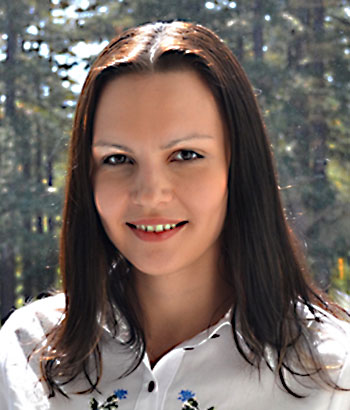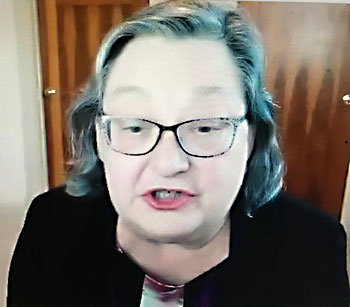Fewer Students on Campus After CZU Fire
By Jondi Gumz
By mid-October, UC Santa Cruz Chancellor Cynthia “Cindy” Larive expects the lab on campus will be able to handle COVID-19 testing of 1,200 to 1,500 times per week.
That’s up from 500 tests a week, she shared with First District Supervisor John Leopold, a 1988 UCSC alumnus, during his Sept. 23 town hall for constituents on Zoom.
Olena Morozova-Vaske, assistant professor of molecular, cell and developmental biology, had the certification required to run a testing lab, and UCSC got approval to start in May.
The county invested close to $1 million in equipment for COVID-19 testing before the CZU Lightning Complex fire in mid-August forced faculty and students to evacuate from the forested campus for the first time in UCSC’s 55-year history.
After the testing equipment arrived, Agilent Technology installed it, putting the campus in a position to dramatically increase the number of samples that can be analyzed.
It’s a PCR test developed by faculty – not a kit sold by a vendor requiring chemical agents that are in short supply.
“Ours is more sensitive, fewer false positives and false negatives,” said Larive, who has a background as an analytical chemist and became UCSC chancellor in July 2019.
Results are available in 48 hours and sometimes in 24 hours.
The campus requires tests for everybody who comes to campus. Faculty who have no symptoms are tested twice a week.
Community Foundation Santa Cruz County provided funds to cover testing of staff at Salud Para La Gente and Santa Cruz Community Health, two nonprofit safety-net clinics.
Don’t expect the campus to expand into doing tests for hospitals.
“We’re not able to do tests for others,” Larive said. “ We’re not able to do billing … Insurance billing turns out to be a really complicated thing. We’re doing our test at cost.”
Typically, billing is outsourced to a third party, but with tests at cost, there’s no profit margin to pay for billing services.
Larive pointed out, “If we take responsibility for ourselves, it frees up resources for others.”
This fall quarter is like no other.
Far fewer students will be on campus, partly due to COVID-19 and partly due to the CZU fire, which destroyed 925 homes in Bonny Doon and Boulder Creek.
All but six classes — chemistry labs, field work, and art studios — are being taught remotely.
“Students don’t have to be here in Santa Cruz,” Larive said, noting plans to house 1,000 students — instead of 8,000 or 9,000 — on campus.
Students in campus housing will be one per room, not grouped together, as in the past.
The library will not be open. Neither will the pool or the gym.
“I want to keep things with as little possibility for spread,” Larive said. “We can evaluate in a month.”
She expects those on campus will get exercise by walking or biking.
Places have been set up to quarantine students if need be, and the “Slug Strong” campaign reminds students to mask up.
This fall, there are more counselors and increased diversity in a “telehealth” model, to respond to the anticipated need.
Enrollment numbers have not been announced yet, but Larive expects the numbers to be similar to a year ago.
“Whether we can increase (students in) housing on campus, we’ll have to wait and see,” she said. “It depends on the level of positivity.”
About 4,000 to 5,000 students are expected to be living off-campus in the community.
Work-study jobs students used to have on campus to help pay for their education are now remote.
“Our IT department, they hired students to be the Zoom IT guru,” Larive said.
Students also are needed as peer mentors and tutors – jobs that will be done remotely.
With the state budget taking a hit from loss of tax revenues due to COVID-19, the UC campuses did likewise — a $21 million cut at UC Santa Cruz, Larive said, noting travel to conferences is out.
The budget gap is larger for units such as housing, parking, dining and the arboretum that depend on volume.
With only 1,000 students on campus instead of 9,000, there’s less need for services and for employees.
“It’s hard when people’s work goes away,” she said.
She has been able to avoid big layoffs so far because the campus got a contract from the county to provide food to evacuees, some sheltered at the Boardwalk’s Coconut Grove – 3,000 meals a day prepared in the Boardwalk kitchen after the fire.
“It helped keep dining workers employed,” Larive said.
Some faculty, staff and students are among the homeless, she said, noting fundraising efforts to help them.
Campus researchers will monitor how the natural reserves regenerate and study how the hydrology is affected.
Leopold said he is concerned about the potential for debris flow once it starts raining, as happened in Santa Barbara.
“The fire is so hot it destroys the capacity of the soil to intake water,” he said.
As for the 2040 long-range development plan, Larive said the university selected enrollment of 28,000 as the number to plan for, “based on how we’ve grown in the past 20 years — it’s not a target, though.”
She added, “Students will be freshmen in 2040 have not been born yet – enrollment doesn’t mean there will be that many people on campus.”
Leopold noted, “The target in the past was met.”
Larive responded, “Understood.”




